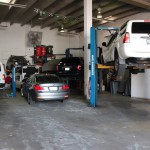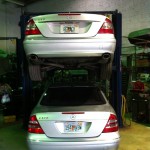
Transmission and Drivetrain Diagnosis
The drivetrain serves two functions: it transfers power evenly from the engine to all drive wheels and it varies the amount of torque. The drivetrain may include the differential, a transfer case (in four-wheel and all-wheel drive cars) and the transmission.
Differential Service
Why is it important?
The differential is a special gearbox located between the drive wheels of your vehicle. It allows the drive wheels to turn at different speeds, as they must when turning a corner. Over time, high operating temperatures can cause the lubricating fluid in the differential to break down, developing a gummy texture that doesn’t lubricate the gears. Replacing the fluid can help you avoid premature wear on the gears in the differential and can even help reduce wear on drive-wheel tires.
What is the service?
The old differential fluid is removed and replaced with new lubricating fluid based on your vehicle manufacturer’s recommendations.
Transfer Case Service
Why is it important?
The transfer case is a gearbox found in four-wheel and all-wheel-drive vehicles. It sends drive power from the engine to the front and rear axles. In all-wheel-drive vehicles, the transfer case helps shift power from one axle to another, depending upon traction conditions. Lubricant fluid in the transfer case helps keep its gears cool and turning smoothly. Replacing this fluid at appropriate intervals prevents premature wear and damage caused by contaminated or broken-down lubricant.
What is the service?
A special fluid is used to lubricate, cool and clean the gears in the transfer case. The old transfer case fluid is removed and replaced with new fluid that conforms to your vehicle manufacturer’s recommendation.
Transmission Services
Automatic Transmission Fluid Exchange
Why is it important?
Transmission gears deliver power from the engine to the drive wheels, shifting automatically to provide the best power and efficiency for your driving speed. A special transmission fluid cools and lubricates the gears. Over time, this fluid degrades and its lubricant qualities diminish. Changing the fluid at the correct intervals prevents premature wear and damage to the transmission.
What is the service?
Removal of the old transmission fluid and replacement with new, clean fluid of the grade recommended by your vehicle manufacturer.
Manual Transmission Service
A transmission is a speed and power-changing device located between the engine and the driving wheels of a vehicle. It provides a means for changing the ratio between engine RPM and driving wheel RPM to meet each particular driving situation.
Manual transmission fluid provides lubrication to gears, bearings, shafts and other components. Heat, pressure and friction can slowly break down the additives in the transmission fluid. In addition, small particles of metal may come off the gears as they wear, and these metal particles can mix with the fluid. Fluids can also become contaminated with water.
Service includes:
- Evacuating old manual transmission fluid
- Adding transmission fluid of the manufacturer’s recommended type and quantity
Axles
Axles are as important as the brakes and tires to the safety of your car.
Axles connect to the wheels and they bear the weight of your vehicle. They also help drive your vehicle, and in most cars are integral parts of the steering system.
Healthy axles improve traction and extend the tire life.
Our experienced mechanics are experts at maintaining all of types of axles, on all types of vehicles such as domestic and foreign automobiles, SUVs and light trucks.
Bearings
Wheel bearings enable wheels on a car to spin freely and stay secured to the car. Most car manufacturers recommend wheel bearing cleaning, re-packing with grease and inspection every 30,000 miles. For recent models with sealed units that cannot be serviced, they would be simply removed and replaced with new ones. This is normally done with brake service.
Common symptoms that indicate that you may need to replace the wheel bearings are:
- Abnormal noise, grinding or squealing from tires when driving
- Steering wheel shakes when driving the car
- If the wheel bearing is locked up, the wheel will not move forward easily
Our experienced team of mechanics will:
- Inspect wheel bearings
- Remove/replace the wheel bearing
- Inspect suspension and steering systems for damaged or worn components




